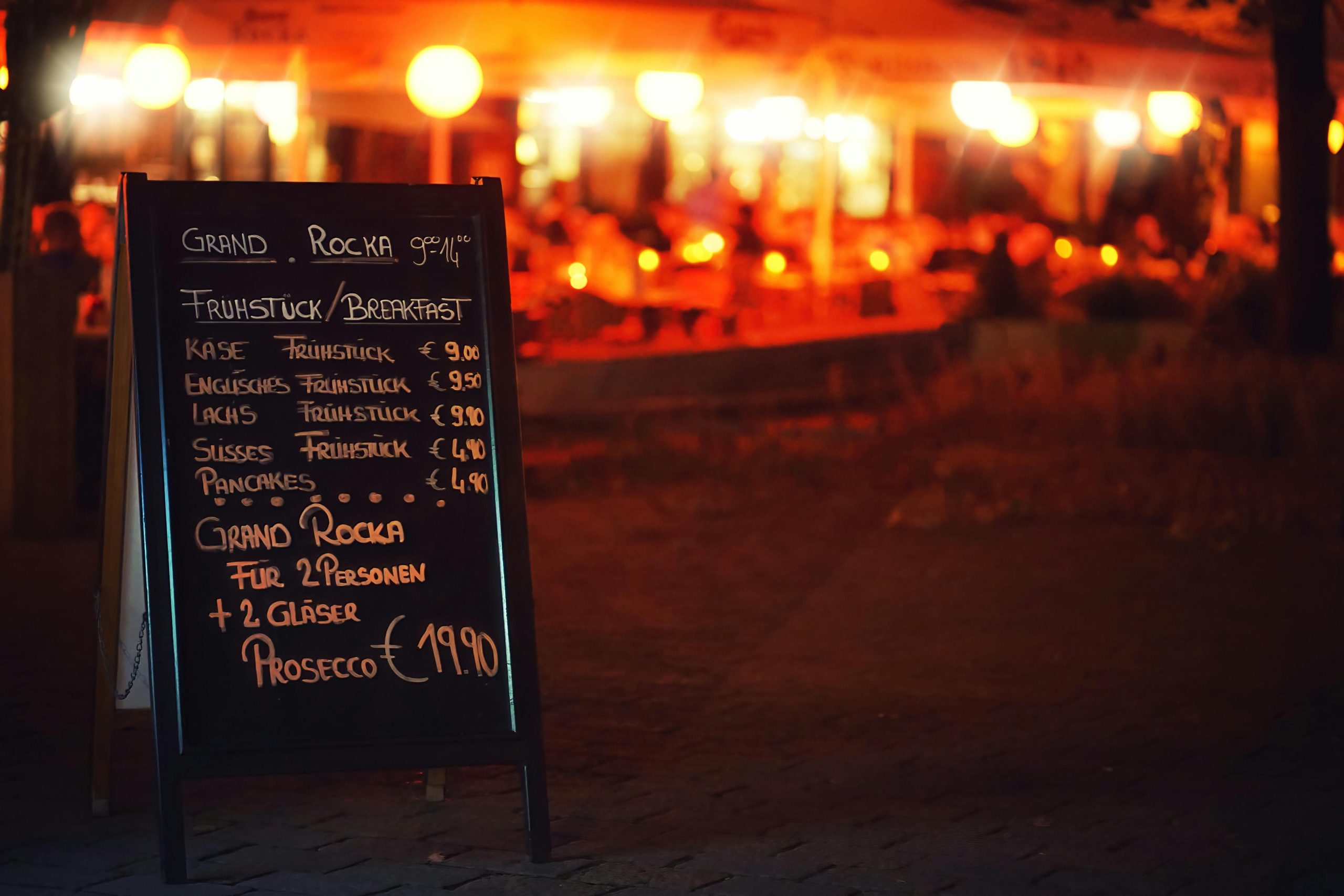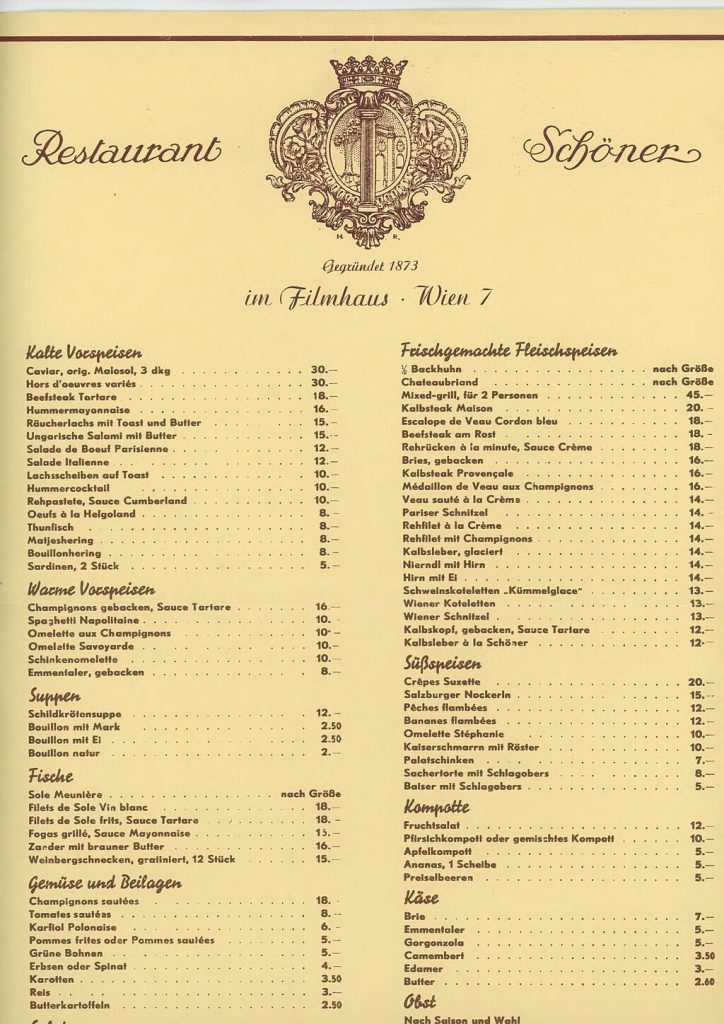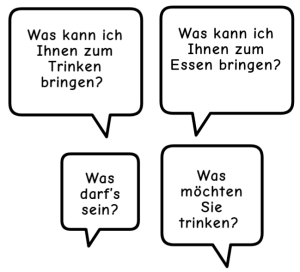6.13 Essen gehen

Guten Abend!
Zum Aufwärmen machen wir unseren Tagesminiplausch und eine Wiederholung.
Wiederholung
In the previous lesson, you learned what to expect at the Supermarkt, including how to ask for help. Let’s review what you have learned.
Imagine you cannot find something on your shopping list. Based on the conversation above, what question do you need to ask the employee to get some help? Write down your question in your written journal and then record it in your audio journal.
Lektionsüberblick
It’s fair to say that many people enjoy dining out from time to time, so it’s important to know how to navigate the restaurant scene in Germany. The German dining experience can be exciting if you are dining in a big city or gemütlich (cozy) if eating in a quaint restaurant. In the end, you will be able to 1) pick a restaurant based on what you want to eat, 2) read a menu, 3) order your meal, and 4) pay for your meal.
1) Ein Restaurant wählen (choosing a restaurant)
As mentioned previously there is no shortage of diversity when it comes to cuisine in Germany. Many different types of restaurants can be found, especially in big cities. Imagine you and your friend are trying to decide what to eat out on the town tonight. They ask, Was für Essen willst du? What type of food do you want? Read, listen, and review the different types of cuisine below.
Now using the clues in the pictures, complete the activity below. Hint: Some images require that you look closely to see the clues.
Kleiner Hinweis
You have learned Ich will (I want). A more polite alternative is, Ich möchte (I would like). The meanings are similar to English. If you are talking with your roommates about what you want to eat tonight, you can say, “Ich will mexikanisch essen,” but if you are talking to someone in a more formal context, you should choose, “Ich möchte…”
Jetzt bist du dran!
2) Die Speisekarte (the menu)
| Take a look at the images. What do you notice about the menu in each picture? That’s correct. It’s often positioned outside of a restaurant in Germany because it will catch the attention of people walking down the street. |  |
 |
The waiter or waitress will also give you a Speisekarte inside. You already know many of the words you might find there. Consider the Gerichte (dishes), Beilagen (side dishes), and Getränke (drinks) you have learned. You will also see a section on the Speisekarte that says Vorspeise. What do you remember about the word vor? Yes, before! So these are foods you eat before your main meal (a.k.a appetizers or starters).
Let’s practice with a scavenger hunt (ein Schnitzeljagd). Once you have found each of the words in the Speisekarte, check them off.
 |
|
Now, look through the foods listed under each category. Pay special attention to the foods that you have learned and recognize. Was willst du essen?
Jetzt bist du dran!
3) Ich möchte bitte…
There are certain questions that you are most certain to hear from the wait staff at a German restaurant. Listen and repeat the following questions to help train your ear to understand them.
 |
Let’s practice how to answer these questions.
|
Remember that you have learned how to express food sensitivities, allergies, and special diets. Here are some examples. Ich bin allergisch gegen [Eier, Erdnüsse, Milch, Soja, usw.] Ich habe eine Glutenunverträglichkeit, Milchunverträglichkeiten, usw.
Or, if you would like to specify a particular diet… Ich esse vegetarisch./Ich bin Vegetarier*in. Ich esse kosher. Ich esse glutenfrei. Ich esse kein Fleisch. |
Kleiner Hinweis
There are notable differences between the dining experience in German-speaking Europe and America. For example there are no free refills on drinks, and tap water (Leitungswasser) is rarely available. In addition, there is usually no hostess to show you to your seat. You just find our own table where you want to sit.
If there is no free table, it is quite customary to sit together with people you don’t even know. You would go to their table and ask: “Entschuldigung, ist hier noch frei?” and usually they would offer you the free seats: “Ja, bitte schön” (unless they’re expecting more of their friends to arrive).
One other notable difference: The waitress or waiter will not come by your table frequently to ask you how your food is. Some might see this as an advantage as you can eat in peace.
🎥Take a look at this Easy German video about how to order at a restaurant.
Österreich im Blickpunkt

Die Kärntner Nudel ist ein dünn ausgewalzter Nudelteig, der zu einer bis zu faustgroßen Tasche geformt und mit verschiedenen Zutaten gefüllt wird. Kärntner Nudeln gibt es mit verschiedensten Füllungen, von herzhaft bis süß, angefangen von der „Kasnudel“ (mit einer Topfen*-Füllung) über die Fleischnudel, die Erdäpfelnudel und die „Herrnpilznudel“ (mit Steinpilz-Füllung) bis zu den süßen Apfelnudeln (Apfel-Zimt-Füllung) und Kletzennudeln (gedörrte Birnen mit Topfen).
*Topfen is called Quark in Germany, Switzerland, and Liechtenstein.
The Carinthian noodle is a thinly rolled out pasta dough, formed into a fist-sized pocket and filled with various ingredients. Carinthian noodles are available with a variety of fillings, from savory to sweet, ranging from Kasnudel (with a curd cheese filling), to meat noodles, potato noodles, and Herrnpilznudel (with porcini mushroom filling), to sweet apple noodles (apple and cinnamon filling) and Kletzennudeln (dried pears with curd cheese).
Jetzt bist du dran!
For this exercise you can look again at this authentic Speisekarte. Imagine that the Kellner (waiter) has asked you, Was darf’s sein? . Choose a dish and a drink from the Speisekarte and answer with, Ich möchte bitte [the name of the dish or drink].
4) Zahlen, bitte! (I’d/we’d like to pay.)
Your time at the restaurant is just about over, but first you have to pay. Listen and repeat how to ask for your check and how to ask if you can pay with a credit card.
Zahlen, bitte!
Kann ich mit Karte zahlen? (or simply, Karte?)
Your waiter might also ask you the following ja oder nein question.
Hat Ihnen alles geschmeckt? = Did you enjoy everything?
You can answer with….Ja, danke or leider nein .
🎥You can watch as the bill for pizza delivery is paid on Nico’s Weg.
Kleiner Hinweis
Tipping is different between the United States and German-speaking countries. When you pay a bill in German-speaking Europe, you only give a small tip (das Trinkgeld) as the service charge is included in the bill. Waitresses and waiters get higher hourly wages than in the North American context. Therefore, people usually tip less; you just round up to the nearest currency unit (9,20€ -> you would give 10€), or if the bill is larger, you round up and add a couple of Euros (37,40€ -> you would give 40€).
Example: How to tip 0,80€ on the 9,20€
- Hand the server a 10€ bill (or two 5€ bills) and say “Das stimmt so.” The server knows not to give you any change.
- Hand the server a bill larger than 10€ and say “10 Euro”. The server knows to give you back change from the 10€. (E.g. If you have handed them a 20€ bill, you will get a 10€ bill back.)
- Hand the server your card and say “10 Euro”. The server knows to charge you 10€ on your card. You typically do not enter a tip on the receipt.
Jetzt bist du dran!
Imagine it is time to pay at the traditional German restaurant that you and your friend are eating at. In your audio journal practice saying, Zahlen, bitte! ) And, Karte? If you are feeling confident, you can try, Kann ich mit Karte zahlen? ) You can also practice giving a tip in different ways.
Zum Schluß

*As you conclude this lesson, don’t forget to check Canvas!*
Before you go!
 You have completed your first semester of German! Herzlichen Glückwünsch! Think about all you have accomplished this semester. If you were traveling to a German-speaking country over break, you would already be able to have a conversation with a German-speaker!
You have completed your first semester of German! Herzlichen Glückwünsch! Think about all you have accomplished this semester. If you were traveling to a German-speaking country over break, you would already be able to have a conversation with a German-speaker!
Don’t end your language journey here, be sure to sign up for your next class (GERM 1020) and make plans to study abroad. As you go forward in your language learning (or want to keep up over break), you can always come back to this book to review!

Media Attributions
- Kleiner Hinweis about eating out in Germany was adapted from Willkommen: Deutsch für alle Copyright © 2020 by Claudia Kost and Crystal Sawatzky is licensed under a CC BY-NC-SA 4.0 International License.
- Kleiner Hinweis about Tipping was adapted from Willkommen: Deutsch für alle Copyright © 2020 by Claudia Kost and Crystal Sawatzky is licensed under a CC BY-NC-SA 4.0 International License.
Media Attributions
- Private: 1010-at-banner-large
- fireworks-1993221_1280

